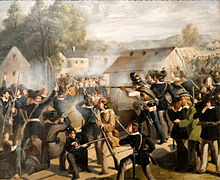Sebastian Frank from Seewies
Sebastian Frank von Seewies (born September 4, 1796 in Pfaffenhausen , † November 20, 1850 in Vienna ) was an Austrian kk major general , teacher at the corps officer school and city commandant of Vienna.
biography
Military career
Born in the Hochstift Augsburg , Bavaria from 1803 , as the son of Captain Karl Frank von Seewies († November 5, 1839 in Krems an der Donau ), Sebastian Frank entered the Theresian Military Academy in Wiener Neustadt and after graduating on October 15 In 1816, as a sub-lieutenant in a pioneer corps, he became first lieutenant in the Prohaska infantry regiment (1824 Eugen Graf Haugwitz) No. 38 on November 1, 1821, as well as a teacher of mathematics, field fortifications and weapons training in the Graz cadet company, a position he held for ten years dressed with great success.
On March 6, 1831 he was promoted to captain and joined the general staff the following year. There it was used partly in the statistical office and partly in the border regulation to Bavaria . In December 1835 he was appointed major and at the end of 1840 he was appointed head of the director's office in Vienna and assigned to the general quartermaster staff in Graz under the direction of Lieutenant Field Marshal Count Leonhard von Rothkirch and Panthen . The officer became lieutenant colonel and commander of the engineer corps with the staff at Vienna in November 1841 , which he commanded after his promotion to colonel in March 1843 . At that time he was the bearer of the Imperial Russian Order of St. Anne and Knight of the Royal Dutch Civil Order of the Belgian Lion . At the same time he was inspector of the Pioneer Corps School in Tulln , where he made significant contributions to the technical and scientific training of the corps. He also completed the regulations for this corps that Colonel Karl von Birago had left behind in the manuscript.
City Commandant of Vienna
On June 21, 1848 he was promoted to major general and deputy city commander of Vienna.
Immediately after the murder of War Minister Count Theodor Baillet von Latour during the October Uprising in Vienna on October 6th, the angry mob demanded the extradition of the actually very popular officer on behalf of the so-called student committee. That was only prevented by the steadfastness of the garrison troops in the bourgeois armory. Finally the Reichstag placed him under its protection, with which the order of the student committee expired. He then took over a brigade in the garrison concentrated in the Schwarzenbergischer Garten, and distinguished himself in taking the Brigittenau and Leopoldstadt , for which he was awarded the Knight's Cross of the Imperial Austrian Leopold Order . After the suppression of the uprising under the leadership of Field Marshal Prince Alfred von Windischgrätz, Frank, now city commandant, issued a ban on posting a poster on November 1st and the order to deliver all cut, stabbing and firearms under threat on November 15th severe consequences if disregarded. He also repeated the ban on billposting of November 1st and sent another warning to the population against making inflammatory speeches in taverns and coffee houses under threat of military criminal law and martial law.
In 1849 he was destined to march to Hungary with a patrol corps, but had to do without and stayed as city commander in Vienna because a painful illness, which he later succumbed to, paralyzed his strength.
literature
- Wenzel Georg Dunder: Memorandum on the Vienna October Revolution. Publishing house property of the author, Vienna 1849.
- Constantin von Wurzbach : Frank von Seewies, Sebastian . In: Biographisches Lexikon des Kaiserthums Oesterreich . 4th part. Typogr.-literar.-artist publishing house. Establishment (L. C. Zamarski, C. Dittmarsch & Comp.), Vienna 1858, p. 328 f. ( Digitized version ).
Individual evidence
- ↑ a b c Th. Jg. Leitner von Leitnertreu: History of the Wiener Neustädter Military Academy. Volume 2, printed and published by Römer & Kamner, Kronstadt 1853, p. 236f.
- ↑ Military schematism of the Austrian Empire. KK Hof- und Staatsdruckerey, Vienna 1827, p. 172.
- ↑ Johann Baptist Schels (Ed.): Austrian military magazine. Volume 3, Issue VII, printed by Anton Strauss's blessed widow, Vienna 1831, p. 110.
- ↑ Österreichisches Biographisches Lexikon 1815-1950, Vol. 9 (Lfg. 43, 1986), p. 287
- ↑ Military schematism of the Austrian Empire. KK Hof- und Staatsdruckerey, Vienna 1839, p. 393.
- ↑ Military schematism of the Austrian Empire. KK Hof- und Staatsdruckerei, Vienna 1848, pp. 406, 408.
- ^ Antonio Schmidt-Brentano: The kk or kuk generality 1816-1918. Austrian State Archives, 1907, p. 183.
- ^ Wenzel Georg Dunder: Memorandum on the Vienna October Revolution. Publisher property of the author, Vienna 1849, pp. 135ff.
- ↑ http://sammlungen.ub.uni-frankfurt.de/1848/content/pageview/2238017
- ^ Sebastian Frank von Seewies: Announcements. KK Hof- und Staatsdruckerei, Vienna 1848.
| personal data | |
|---|---|
| SURNAME | Frank von Seewies, Sebastian |
| BRIEF DESCRIPTION | Austrian major general and teacher |
| DATE OF BIRTH | 4th September 1796 |
| PLACE OF BIRTH | Pfaffenhausen |
| DATE OF DEATH | November 20, 1850 |
| Place of death | Vienna |

